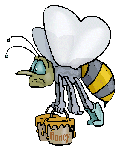
Honey - How we get it.
It is important to remember that the honey we remove from the bees is surplus to their requirements. Honey bees naturally gather more honey than they need for their own purposes and in a good nectar flow situation, as long as the Beekeeper keeps putting supers on top of the hive the bees will continue to fill them.
The Beekeeper can remove the surplus honey at any time after it is capped over and the total of this honey is his surplus for the year. The main months for honey are from May to September. Usually May to August produces mixed floral honeys though in early Spring the Beekeeper may take the hives to Oil Seed Rape which produces honey of one type. Similarly, in late August and into September the bees will collect Heather Honey if they are taken to the Heather Moors.
All the Honey to be extracted must be fully capped, ensuring it is 'ripe'. The combs of honey are first uncapped using either an uncapping fork, which has many tines, or by using an uncapping knife.
The combs of honey are then placed in an extractor which is similar to a domestic spin drier. This spins the combs and the honey is thrown out by centrifugal force, it runs down the walls to the bottom of the extractor. The honey is filtered to remove any wax pieces and run off into a settling tank which allows any air bubbles to rise to the surface. The settling process can take a few days depending on how viscous the honey is, after settling the honey is then ready for bottling.
All honey starts in a liquid, or runny state, and after a period of time will thicken to eventually become granulated or "set" honey. There is nothing wrong with honey which is liquid when purchased but which sets with time. To return it to its liquid state simply gently heat in hand hot water (less than 50 degrees C) for a short time.
Some Beekeepers sell Cut Comb Honey; as the name implies the comb is cut into chunks using a stainless steel cutter and placed in a plastic container. All the contents can be eaten, both the wax and the honey, and Comb honey is highly prized because of its higher flavour than extracted honey and also because it is virtually untouched from the product produced by the bees. It will contain pollen from the flowers visited by the bees which may have been removed by filtering.
 Download Membership form
Download Membership form